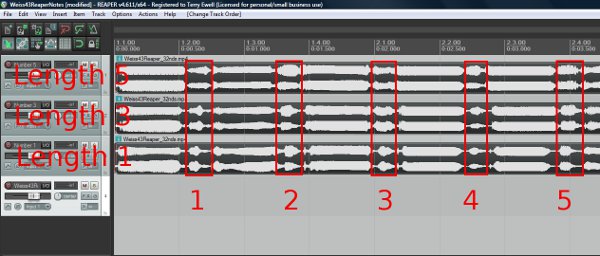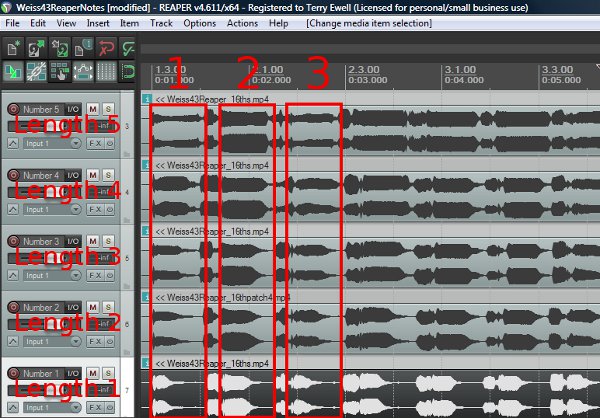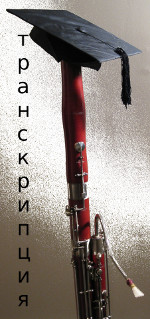Practicing Weissenborn Study #43. Weissenborn Opus 8/2, Study #43 for advanced bassoon students. Phrasing with varied articulations. Quotation from Beethoven's Heiligenstadt Testament. By Terry B. Ewell, Bassoon Digital Professor. Translated by Elena Iakovleva. BDP#151. www.2reed.net.
Изучение этюда
Nº43. Вайсенборн опус 8/2, этюд №43 для продвинутых студентов
фаготистов. Фразировка с различными артикуляциями. Цитата из Завета
Хайлигенштадта Бетховена.Терри Б. Юэлл, Цифровый Профессор Фагота.
Перевод, Елена Яковлева. BDP # 151. www.2reed.net.
TUTORIAL Руководство
1. Welcome, this is Terry Ewell. Many editions of this study miss the important note that Weissenborn gives to the student. The original text to this study explains Weissenborn’s inspiration:1. Добро пожаловать, это Терри Юэлл. Во многих изданиях этого этюда отсутствует важная заметка, которую Вайссенборн дает студенту. Оригинальный текст для этого этюда объясняет что вдохновило Вайссенборна:
2. “Study based on the main motive of the 2nd movement of Beethoven’s 4th Symphony. A rhythmical tongue and a sensitive ear are needed above all to play this well.”
2. «Этюд по главному мотиву 2-й части 4-й симфонии Бетховена. Прежде всего, ритмичный язык и чувствительный слух необходимы, чтобы хорошо его сыграть ».
3. Before we examine the study, let’s first consider the excerpt.
3. Прежде изучения этюда, давайте сначала рассмотрим этот пассаж.

4. 7я строчка этюда не идентична пассажу, но вы можете ясно увидеть, как Вайссенборн подражает этой части соло фагота, даже если не все ноты совпадают.

5. Этот этюд довольно труден по причинам, указанным Вайссенборном. Ученик обязан поддерживать точный ритм, устойчивый темп и поддерживать «чувствительный слух».
6. Lines 9 and 10 provide an opportunity to practice phrase shaping during articulated notes and rests. Mastering the exercises I give to you below will really help you to gain control over your articulation.
6. 9я и 10я строки дают возможность позаниматься формированиям фраз во время артикулированных нот и пауз. Овладение этими моими упражнениями, действительно поможет вам контролировать артикуляцию при игре.

First all slurred.
7. Сначала давайте потренируемся этим пассажем с разными артикуляциями. Используйте метроном. Я использую темп 84 для восьмой ноты. Сначала играйте все легато.
8. I suggest practicing it slurred several times, so you can really sense the phrasing you are making with your air. When you achieve a phrasing you like, you will need to keep this regardless of what the tongue does.
8. Я предлагаю поучить это несколько раз легато, чтобы вы могли по-настоящему ощутить выражение, которое вы делаете вашим воздухом. Когда вы достигнете фразировку, которая вам нравится, вы должны будете сохранять это независимо от того, что делает язык.
9. The 32nd note is very relatively fast, so I don’t think I can distinguish five different articulations on that note. I should be able to make three different articulations, however: legato tonguing (5), medium (3), and staccatissimo (1). Just for our practice here I will keep the 16th note with legato tonguing and vary just the 32nd note. First I will do it on a single tone and then as written.
9. 32-я нота очень быстрая, поэтому я не думаю, что я смогу сделать пять разных видов артикуляции на этой ноте. Однако я должен быть в состоянии сделать три разных артикуляции: легато с языком (5), средний (3) и стаккатиссимо (1). Для наших занятий я оставлю 16-ю ноту легато с языком и буду изменять только 32-ю. Сначала я сделаю это на одной ноте, а затем, как написано.

10. Давайте посмотрим на звуковые волны, которые я произвел. Я создал короткий аудиоклип, а затем выстроил графики звуковых волн в программе под названием «Reaper». Верхний канал показывает длину номер 5, следующий канал имеет длину номер 3, а последний канал имеет длину номер 1.
11. Visual observation shows some inconsistencies with the length of the 32nds and especially the timing of the notes. Boxes number 1, 4, and 5 are pretty good. The notes show the correct lengths and generally start at the right time. Boxes 2 and 3, however, show timing problems especially with note length 5. I am also not quite as pleased with the note lengths.
11. Визуальное наблюдение показывает некоторые несоответствия с длиной 32-х нот и особенно синхронизация нот. Квадраты № 1, 4 и 5 довольно хорошо вышли. Ноты показывают правильную длину и обычно начинаются в нужное время. Однако в квадратах номер 2 и 3 есть проблемы с синхронизацией, особенно с длиной нот номер 5.
12. Remember that the starts to each note should occur with the same timing. It is only the duration of the 32nd note that is varied here.
12. Помните, что начало каждой ноты должно происходить в одно и тоже время. Здесь изменяется только длинна 32-й ноты.
13. Now let’s practice by varying the length of the 16th note from 5 to 1, with all of the articulations. I will keep the 32nd note at number 5.
13. Теперь давайте потренируемся, изменяя длину 16-й ноты с 5го до 1го номера со всеми артикуляциями. Я буду держать 32-ю ноту под номером 5.
14. It is a real challenge to keep the phrase shape the same and change the articulations.
14. Это сложная задача, сохранить форму фразы изменяя артикуляцию.

15. Опять же, мы смотрим на представление звуковых волн на аудио станции, «Reaper». Каналы располагаются от длины номер 5 сверху до длины номер 1 снизу. Вы можете видеть, что я отлично контролирую длину нот. С редким исключением, есть четкие различия между длинами 16-ых нот в коробках номер 1, 2 и 3, и следующими звуковыми волнами. Однако, есть несоответствия в синхронизации нот. Мне нужно побольше над этим работать!
16. When you have mastered those articulations, “mix and match” the notes. For instance, try playing “5” on the 16th notes and “1” on the 32nds. Or “2” on the 16th notes and “5” on the 32nds. Gaining this command of your articulation will open up a whole new world of musical expression for you!
16. Когда вы освоите эти артикуляции, попробуйте их на нашей мелодии. Например, попробуйте сыграть артикуляцию номер 5 на 16-х нотах и номер 1 на 32-х. Или номер 2 на
16-х нотах и номер 5 на 32-х. Владение артикуляции откроет для вас целый новый мир музыкального выражения!
REFLECTION Размышление
17. “Almighty God, you look down into my innermost soul, you see into my heart and you know that it is filled with love for humanity and a desire to do good.”17. «Всемогущий Бог, ты заглядываешь в мою внутреннюю душу, ты заглядываешь в мое сердце и знаешь, что оно наполнено любовью к человечеству и желанием делать добро».
18. We don’t know the suicide rate for those living in the 1800s in Europe, but Beethoven was certainly a candidate for an early death. His own writings detail his despair with life due to his loss of hearing. The document named Heiligenstadt Testament indicates the severity of his despair and his thoughts about giving up on living. The quote I read at the beginning of this reflection is taken from the Heiligenstadt Testament. This is Beethoven’s prayer to God.
18. Мы не знаем количество самоубийств среди тех, кто жил в Европе в 19том веке, но Бетховен, безусловно, был кандидатом на раннюю смерть. Его собственные тексты описывают его отчаяние от жизни из-за потери слуха. Документ под названием «Завет Хайлигенштадта» указывает на серьезность его отчаяния и его мыслей об отказе от жизни. Цитата, которую я прочитал в начале этого размышления, взята из Завета Хайлигенштадта. Это молитва Бетховена Богу.
19. Beethoven’s faith in God played an important role in helping him through this difficult time. Despite his torment and problems, Beethoven had much beautiful music yet to give to the world. Perhaps you are going through difficulties now. My prayer for you is that God will help you through those problems so that you can provide others with many blessings from your talents.
19. Бетховена вера в Бога сыграла важную роль, помогая ему в это трудное время. Несмотря на его мучения и проблемы, у Бетховена было еще много прекрасной музыки, чтобы дать миру. Возможно, вы сейчас переживаете трудности. Я молюсь за вас, чтобы Бог помог вам преодолеть эти проблемы, чтобы вы могли дать другим много благословений от ваших талантов.
PERFORMANCE Исполнения
20. I regret that I am not able to supply you with a performance of
this study. Upon listening to my recording, I realize that I slipped
into a very common error: performing with a triplet rhythm rather than
the divisions of four required.I will perform for you here portions of the study, but regrettably the recording will not be to same standards as those performed in the Towson University Recital Hall.
20. К сожалению, я не могу предоставить вам исполнения этого этюда. Прослушав мою запись, я понимаю, что я совершил очень распространенную ошибку: я сыграл ритмом триолей, а не делением на четыре, как написано.
Я сыграю для вас некоторые части этюда здесь, но, к сожалению, запись будет нижнего качество, чем записи в концертном зале
CREDITS 感谢
Beethoven 4th graphic
http://javanese.imslp.info/files/imglnks/usimg/2/2a/IMSLP35615-PMLP01585-Beethoven-Op060.Bassoon.pdf
Beethoven quotation: Maynard Solomon, Beethoven Essays, (London: Harvard University Press, 1988), p. 218.
